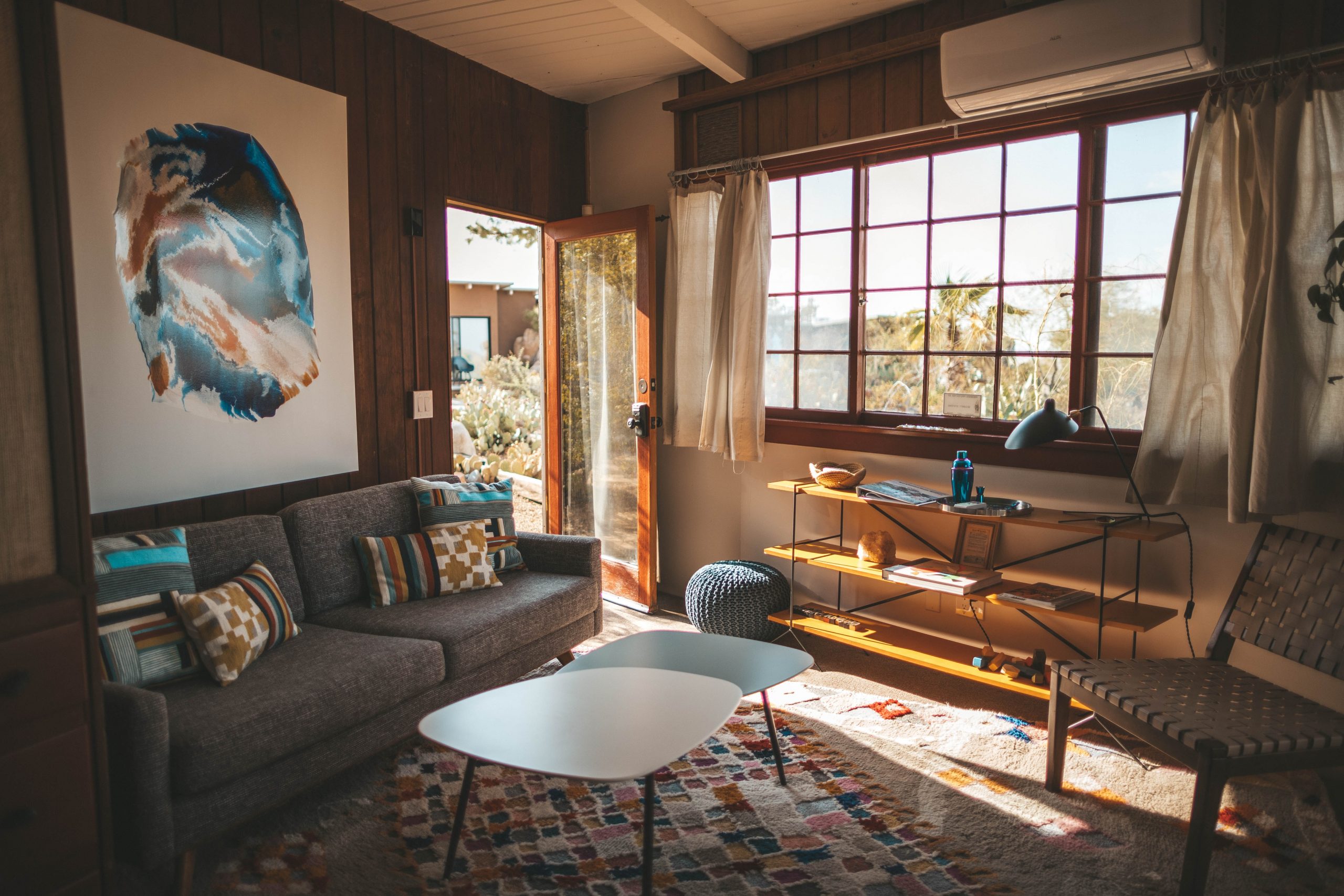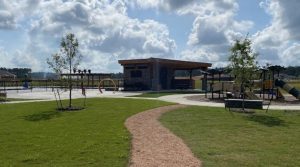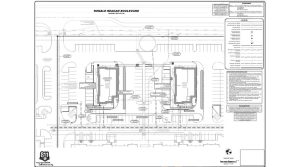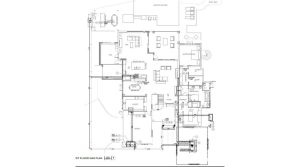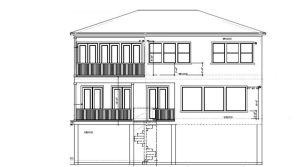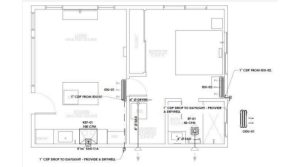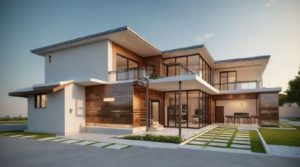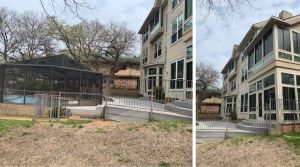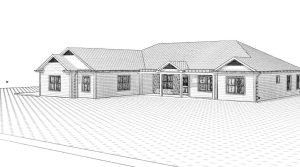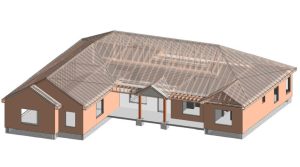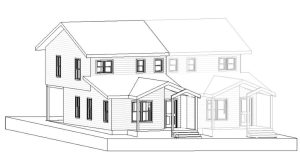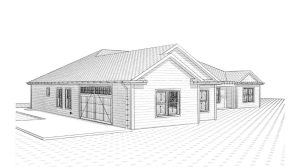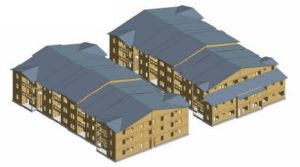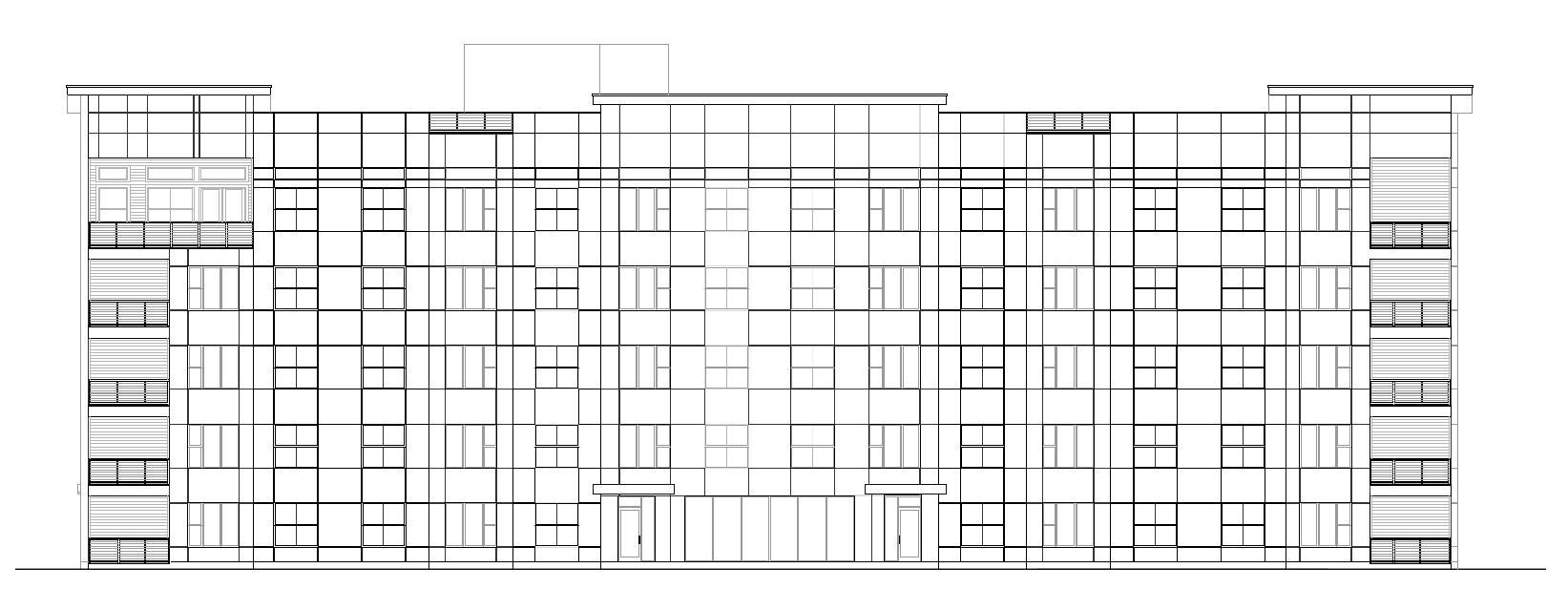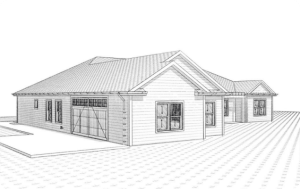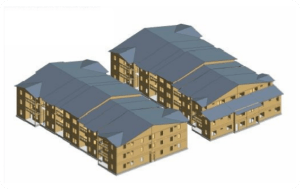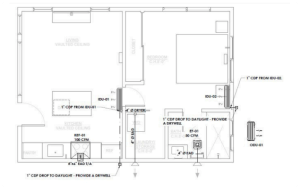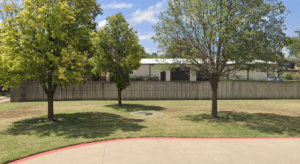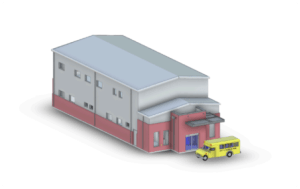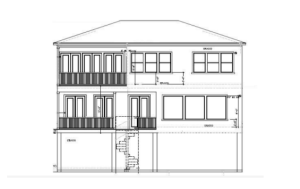Harnessing the Power of Natural Light: Optimizing Building Design for Shorter Days
Natural light has always been a vital component of architectural design. However, the importance of natural light is often understated, especially during the shorter days of winter when we are exposed to less natural light. The importance of natural light goes beyond just saving energy; it has a direct impact on our physical and mental health. Studies have shown that natural light can boost our mood, improve our sleep, increase productivity, and create a sense of well-being. In this blog post, we’ll explore how to optimize building design for shorter days, including the use of skylights, large windows, and other design elements that maximize natural light. Whether you’re designing a new building or just looking to improve the lighting in an existing space, this post will provide you with the tools and knowledge you need to harness the power of natural light.
1. Introduction: The impact of natural light on our well-being and productivity
Natural light has a profound influence on our daily lives, affecting our mood, energy levels, and overall well-being. As the days grow shorter during certain seasons, it becomes even more crucial to optimize building design to maximize the benefits of natural light.
Scientific studies have consistently shown that exposure to natural light can have a significant positive impact on our mental and physical health. It helps regulate our circadian rhythm, the internal clock that governs our sleep-wake cycle, hormone production, and overall body function. When we receive ample natural light, we feel more alert, focused, and motivated, leading to increased productivity and enhanced cognitive performance.
Furthermore, natural light is known to uplift our mood and reduce the risk of conditions such as seasonal affective disorder (SAD), which is characterized by low mood and decreased energy levels during the darker months. By incorporating natural light into our built environments, we can create spaces that promote well-being, creativity, and a sense of connection with the outdoors.
Optimizing building design to harness the power of natural light involves careful consideration of various factors. These include the placement and size of windows, the orientation and layout of rooms, and the use of reflective surfaces to distribute light effectively. By prioritizing natural light in our architectural designs, we can create spaces that not only benefit our health but also minimize reliance on artificial lighting, leading to reduced energy consumption and environmental impact.
In this blog series, we will explore practical strategies and innovative techniques for optimizing building design to make the most of natural light, especially during the shorter days. From passive solar design principles to smart lighting systems, we will delve into a range of approaches that architects, designers, and homeowners can employ to create spaces that enhance our well-being and productivity, all while embracing the beauty and vitality of natural light. So let’s dive in and discover how we can harness the power of natural light to transform our built environments.
2. Understanding the benefits of natural light in building design
Understanding the benefits of natural light in building design is crucial for creating spaces that are not only visually appealing but also promote wellbeing and productivity. Natural light has a profound impact on our physical and mental health, making it a key consideration when designing any space.
First and foremost, natural light has been proven to enhance our mood and overall wellbeing. Sunlight triggers the release of serotonin, a hormone that helps regulate our mood, sleep patterns, and overall sense of happiness. Therefore, incorporating ample natural light into building design can have a positive impact on the occupants’ mental health, reducing the risk of depression and improving overall satisfaction.
Moreover, exposure to natural light has been linked to increased productivity and cognitive function. Studies have shown that individuals working in well-lit spaces experience higher levels of alertness, focus, and performance compared to those in dimly lit environments. Natural light provides a sense of connection to the external environment, reducing eye strain and fatigue, thereby enhancing productivity and reducing the likelihood of errors or accidents.
In addition to its psychological benefits, natural light also offers significant energy-saving advantages. By strategically designing spaces to maximize the use of natural light, building owners can significantly reduce their reliance on artificial lighting during daylight hours. This not only reduces energy consumption and lowers utility costs but also contributes to a more sustainable and environmentally friendly building design.
Lastly, natural light plays a vital role in creating an aesthetically pleasing and inviting atmosphere. It enhances the visual appeal of indoor spaces, highlighting architectural features and creating a sense of openness and spaciousness. Natural light also helps to showcase interior design elements, colors, and textures, making them appear more vibrant and engaging.
In conclusion, understanding and harnessing the benefits of natural light in building design can have a profound impact on the overall experience and functionality of a space. From improving mood and productivity to saving energy and creating visually appealing environments, natural light is a powerful tool that should be thoughtfully integrated into any building design.
3. Recognizing the challenges of shorter daylight hours
As the days grow shorter during the winter months, it becomes essential to recognize the challenges that come with limited daylight hours and their impact on building design. With less natural light available, buildings can become dim and gloomy, affecting the overall mood and productivity of its occupants.
One of the main challenges is the decreased availability of natural light. Sunlight provides numerous benefits, including improved mood, increased vitamin D synthesis, and enhanced productivity. However, during winter, the sun rises later and sets earlier, resulting in reduced daylight hours. This poses a challenge for architects and designers to find creative solutions to compensate for the lack of natural light.
Another challenge is the quality of natural light during the winter season. The angle at which the sun’s rays hit the Earth changes, leading to a lower intensity and a colder color temperature. This can create a dull and uninviting atmosphere within buildings. Recognizing this challenge is crucial in optimizing building design to maximize the benefits of natural light.
Additionally, the orientation and location of a building play a significant role in the amount of natural light it receives. Buildings that are surrounded by tall structures or are situated in shaded areas may face even greater difficulties in harnessing natural light. Understanding these factors helps architects and designers develop strategies to overcome these challenges, such as incorporating light wells, skylights, or strategically placed windows to capture as much natural light as possible.
By recognizing the challenges posed by shorter daylight hours, architects and designers can focus on developing innovative solutions to optimize building design. From incorporating light-enhancing materials to utilizing technology that redirects and amplifies natural light, there are numerous opportunities to create spaces that are well-lit, inviting, and conducive to productivity, even during the darkest times of the year.
4. Utilizing daylighting strategies for optimal natural light
As the days grow shorter and the nights longer, it becomes increasingly important to harness the power of natural light in building design. Daylighting strategies can greatly enhance the overall atmosphere and functionality of a space, while also reducing energy consumption and promoting well-being.
One effective daylighting strategy is to maximize the use of windows and skylights. By incorporating large, strategically placed windows and skylights, natural light can flood into the interior, creating a bright and inviting environment. Not only does this reduce the need for artificial lighting during daylight hours, but it also provides occupants with a connection to the outdoors and a sense of openness.
To optimize natural light, it is crucial to consider the orientation and placement of windows. South-facing windows tend to receive the most direct sunlight throughout the day, making them ideal for capturing natural light. East-facing windows are beneficial for capturing morning sunlight, while west-facing windows can provide warm afternoon light. By strategically positioning windows based on the building’s orientation, designers can maximize the amount of natural light that enters the space.
In addition to windows and skylights, other elements can be incorporated to enhance daylighting. Light-colored walls and ceilings can help reflect and distribute natural light throughout the space. Similarly, the use of light-colored or reflective materials for flooring and furniture can further enhance the overall brightness of the room.
It is also important to consider the control of natural light. The use of shading devices, such as blinds or louvers, can help regulate the intensity of sunlight entering the space. This allows occupants to adjust the amount of natural light according to their preferences and the changing daylight conditions.
By utilizing these daylighting strategies, buildings can be optimized to take full advantage of natural light during the shorter days. Not only does this create a visually appealing and comfortable environment, but it also contributes to energy efficiency and the well-being of the occupants. So, let the power of natural light illuminate your space and embrace the beauty of shorter days.
a. Incorporating large windows and skylights
Incorporating large windows and skylights into building design is a brilliant way to harness the power of natural light, especially during the shorter days of the year. Not only does it enhance the aesthetics of the space, but it also offers a plethora of benefits for both the occupants and the environment.
Large windows allow an abundance of natural light to flood into the building, creating a bright and inviting atmosphere. This not only improves the overall mood and productivity of the occupants but also reduces the reliance on artificial lighting during daylight hours. The ample natural light can positively impact our circadian rhythm, promoting better sleep patterns, enhanced focus, and increased overall well-being.
Skylights, on the other hand, offer a unique way to bring natural light deep into the interior spaces of a building. By strategically placing them in areas that lack direct access to windows, such as corridors or central atriums, skylights can transform dim and shadowy areas into vibrant and lively spaces. The natural light that filters through skylights creates a sense of connection with the outdoors, making occupants feel more connected to nature even inside the building.
Furthermore, incorporating large windows and skylights can significantly reduce the need for artificial lighting during daylight hours, leading to substantial energy savings. By utilizing natural light as the primary light source, buildings can minimize their carbon footprint and contribute to a more sustainable future.
When designing with large windows and skylights, it is crucial to consider factors such as the building’s orientation, glazing technology, and shading devices. Proper orientation and the use of high-performance glazing can maximize the amount of daylight entering the building while minimizing heat gain or loss. Additionally, incorporating appropriate shading devices, such as blinds or overhangs, can help regulate the amount of sunlight entering the space, preventing glare and excessive heat buildup.
In conclusion, incorporating large windows and skylights into building design is a powerful way to optimize natural light and enhance the overall experience of the space. Not only does it create a visually appealing environment, but it also promotes human well-being, energy efficiency, and a sustainable future. By harnessing the power of natural light, we can transform our buildings into vibrant, healthy, and sustainable spaces that adapt to the changing seasons and shorter days.
b. Positioning buildings to maximize sunlight exposure
When it comes to optimizing building design for shorter days, one important factor to consider is the positioning of buildings to maximize sunlight exposure. Natural light not only creates a pleasant and inviting atmosphere but also has numerous benefits for both the occupants and the environment.
To harness the power of natural light, architects and designers should carefully evaluate the orientation of a building. By strategically positioning the structure, it is possible to take full advantage of the available sunlight throughout the day, especially during the shorter winter months.
Ideally, buildings should be aligned to face south, as this orientation provides the maximum amount of sunlight throughout the day. Southern exposure allows for optimal solar gain, which can help reduce the reliance on artificial lighting and heating systems, consequently lowering energy consumption and costs.
Furthermore, incorporating large windows or skylights on the southern side of the building can efficiently capture and distribute natural light deep into the interior spaces. This not only enhances the visual appeal of the building but also contributes to the well-being and productivity of its occupants.
However, it is important to strike a balance between maximizing sunlight exposure and minimizing unwanted heat gain during the summer months. Proper shading devices, such as overhangs, louvers, or exterior blinds, can be integrated into the building’s design to control the amount of sunlight entering the space, ensuring a comfortable indoor environment year-round.
Consideration should also be given to the surrounding landscape and potential obstructions that could cast shadows on the building. Trees, neighboring structures, or even the building’s own design elements should be taken into account during the planning phase to avoid blocking or limiting sunlight access.
By intelligently positioning buildings to maximize sunlight exposure, architects and designers can create spaces that are not only aesthetically pleasing but also environmentally friendly and energy-efficient. Embracing natural light as a valuable resource can significantly enhance the overall design and functionality of a building, making it a more desirable and sustainable place for occupants, especially during the shorter days of winter.
c. Using light-colored surfaces and reflective materials
Using light-colored surfaces and reflective materials is a smart approach to optimize building design for shorter days. By incorporating these elements into your architectural plans, you can effectively harness the power of natural light and create spaces that feel brighter and more inviting during the darker months.
Light-colored surfaces, such as light-colored paint or tiles, have the ability to reflect natural light rather than absorbing it. This means that even on cloudy or overcast days, these surfaces will bounce light around the room, helping to illuminate the space. The use of light-colored walls, ceilings, and floors can make a significant difference in the overall brightness of a room, creating a more cheerful and energetic environment.
In addition to light-colored surfaces, incorporating reflective materials into the design can further enhance the benefits of natural light. For instance, using mirrors strategically can help to amplify the amount of light in a room. Placing mirrors opposite windows or in darker corners can effectively bounce light around, making the space feel larger and brighter.
Another way to incorporate reflective materials is by using glass or other translucent materials for windows, doors, or partitions. These materials allow natural light to pass through while also reflecting it into the adjacent areas. This not only maximizes the utilization of sunlight but also creates a sense of openness and connectivity between different spaces.
By intentionally selecting light-colored surfaces and incorporating reflective materials, you can optimize your building’s design to make the most of natural light during the shorter days. This approach not only enhances the aesthetic appeal of the space but also contributes to the well-being and productivity of its occupants. Embracing the power of natural light in your building design is a sustainable and cost-effective way to create a warm and inviting environment, regardless of the season or time of day.
5. Incorporating interior design elements to enhance natural light
When it comes to optimizing building design for shorter days, incorporating interior design elements that enhance natural light can make a significant difference. Natural light not only creates a warm and inviting atmosphere but also provides numerous benefits for both physical and mental well-being.
One way to maximize natural light is by strategically placing windows and skylights throughout the building. These openings allow sunlight to flood into the space, illuminating the interior and reducing the need for artificial lighting during daylight hours. Additionally, consider the orientation of the building and the placement of rooms to ensure that areas that are used most frequently receive the most natural light.
Another effective technique is to use light-colored and reflective surfaces in the interior design. Light-colored walls, ceilings, and floors can help bounce natural light around the room, making it feel brighter and more spacious. Additionally, incorporating reflective materials such as mirrors or glass in strategic locations can further enhance the distribution of natural light within the space.
Furthermore, using translucent or sheer window treatments can allow natural light to filter through while still offering privacy and diffusing harsh sunlight. These window treatments create a soft and diffused lighting effect, creating a more comfortable and visually pleasing environment.
Incorporating interior design elements that prioritize natural light not only reduces energy consumption but also creates a more pleasant and productive space for building occupants. By harnessing the power of natural light, you can optimize building design for shorter days and enhance the overall experience within the space.
a. Choosing light-colored paints and finishes
When it comes to optimizing building design for shorter days, one of the key considerations is the choice of paints and finishes. By opting for light-colored paints and finishes, you can harness the power of natural light to brighten and enhance the interior spaces.
Light-colored paints and finishes are highly reflective, allowing them to bounce natural light around the room and create a sense of brightness. This is particularly important during the winter months when daylight hours are limited, and the sun’s rays are less intense. By using light-colored paints on walls, ceilings, and other surfaces, you can maximize the amount of natural light that enters the space, making it feel more open, inviting, and energizing.
Furthermore, light-colored paints can also have a positive impact on the overall ambiance and mood of a room. Lighter shades tend to create a sense of spaciousness and airiness, making the space feel larger and more welcoming. This can be especially beneficial in areas with limited windows or natural light sources.
In addition to their aesthetic and mood-enhancing qualities, light-colored paints and finishes can also contribute to energy efficiency. By allowing more natural light to penetrate the space, you can reduce the need for artificial lighting during daylight hours, thereby lowering energy consumption and reducing utility costs.
When selecting light-colored paints and finishes, it’s important to consider the specific needs and goals of each space. Different shades and tones can evoke different emotions and have varying effects on the overall atmosphere. It’s advisable to consult with an interior designer or color specialist to ensure the chosen colors align with the desired aesthetic and functional objectives.
In conclusion, choosing light-colored paints and finishes is a simple yet effective way to optimize building design for shorter days. By maximizing the use of natural light, you can create brighter, more inviting spaces that not only enhance the overall ambiance but also contribute to energy efficiency.
b. Utilizing mirrors and glass partitions
One way to optimize building design and harness the power of natural light during shorter days is by utilizing mirrors and glass partitions. These elements have the remarkable ability to reflect and transmit light, creating a brighter and more spacious atmosphere within the building.
Mirrors strategically placed in areas where natural light is abundant can help bounce light around the space, effectively multiplying its presence. This not only enhances the overall brightness but also creates a sense of openness and depth. By strategically positioning mirrors in corridors, hallways, or even smaller rooms, you can maximize the impact of natural light, making the space feel more inviting and vibrant.
Glass partitions are another effective tool in optimizing building design for shorter days. They allow natural light to flow through different areas of the building, eliminating the need for artificial lighting during daylight hours. By using glass partitions instead of solid walls, you can create a seamless visual connection between spaces, while still maintaining privacy and functionality.
In addition to their practical benefits, mirrors and glass partitions also contribute to the aesthetic appeal of the building. The reflective surfaces of mirrors add a touch of elegance and sophistication, while glass partitions create a modern and contemporary look. These design elements can elevate the overall ambiance of the space, making it more appealing to occupants and visitors alike.
When incorporating mirrors and glass partitions into building design, it’s important to consider their placement and orientation. Strategic positioning will ensure that natural light is maximized and evenly distributed throughout the space. Additionally, the use of energy-efficient glass can further enhance the performance of these design elements, reducing heat loss and optimizing energy consumption.
By harnessing the power of natural light through the use of mirrors and glass partitions, building designers can create spaces that are not only visually appealing but also energy-efficient. These design strategies not only benefit occupants by providing a brighter and more comfortable environment but also contribute to sustainability efforts by reducing reliance on artificial lighting.
c. Designing open floor plans and minimizing obstructions
When it comes to optimizing building design for shorter days and maximizing the use of natural light, designing open floor plans and minimizing obstructions is crucial. Open floor plans allow for better light distribution throughout the space, creating a bright and inviting atmosphere.
By removing unnecessary walls and partitions, natural light can seamlessly flow from one area to another, eliminating dark corners and creating a sense of openness. This not only enhances the overall aesthetic appeal but also improves the functionality of the space.
In addition to open floor plans, it’s important to minimize obstructions that can hinder the penetration of natural light. This includes strategically placing furniture, fixtures, and equipment to avoid blocking windows or light sources. Consideration should also be given to the use of materials and finishes that reflect and amplify natural light, such as light-colored walls, floors, and ceilings.
Moreover, incorporating elements like skylights, large windows, and glass partitions can significantly increase the amount of natural light entering the building. These architectural features not only provide ample daylight but also offer stunning views of the surrounding environment, creating a connection with nature that can positively impact the occupants’ well-being and productivity.
By designing open floor plans and minimizing obstructions, architects and designers can harness the power of natural light and create spaces that are not only visually appealing but also energy-efficient. Embracing the abundant natural light during shorter days can transform buildings into vibrant and sustainable environments that enhance the overall experience for occupants.
6. Implementing smart lighting controls to supplement natural light
Implementing smart lighting controls is a crucial aspect of optimizing building design for shorter days and harnessing the power of natural light. While natural light is undoubtedly beneficial, it may not always be available in sufficient quantities, especially during the winter months or in buildings with limited access to windows.
Smart lighting controls allow for the precise adjustment of artificial lighting based on the availability of natural light. These systems utilize sensors to measure the amount of daylight in a space and automatically adjust the intensity of artificial lighting accordingly. This not only ensures optimal lighting levels but also helps to conserve energy by reducing unnecessary artificial lighting.
One popular smart lighting control technique is daylight harvesting. This method utilizes sensors to detect the amount of natural light entering a space and adjusts the artificial lighting to maintain consistent illuminance levels. When the natural light is abundant, the artificial lights dim or turn off, minimizing energy consumption. Conversely, when natural light diminishes, the system increases the output of artificial lighting to maintain desired light levels.
Furthermore, integrating smart lighting controls with advanced scheduling and automation features can enhance energy efficiency and user comfort. These systems can be programmed to automatically adjust lighting based on the time of day, occupancy, and specific user preferences. For instance, lights can be scheduled to gradually dim as natural light increases, creating a smooth transition between natural and artificial lighting.
In addition to energy savings, smart lighting controls can contribute to creating a healthier and more productive indoor environment. They can be programmed to simulate the changing qualities of natural light throughout the day, such as warmer tones in the morning and cooler tones in the afternoon, which can positively influence the well-being and circadian rhythms of building occupants.
By implementing smart lighting controls, building designers can optimize the utilization of natural light while ensuring a comfortable and energy-efficient indoor environment. This integration of technology and design enables the harnessing of natural light’s benefits, even during the shorter days of the year.
a. Installing automated lighting systems
Installing automated lighting systems can be a game-changer when it comes to optimizing building design for shorter days. As the days grow shorter and natural light becomes scarce, having a lighting system that can seamlessly adjust to changing lighting conditions can greatly enhance the comfort and productivity of occupants.
Automated lighting systems utilize sensors and timers to detect the level of natural light available and adjust artificial lighting accordingly. This ensures that the right amount of light is provided at the right time, reducing energy consumption and creating a more sustainable building design.
One of the key benefits of automated lighting systems is their ability to mimic natural lighting patterns. By incorporating features such as gradual dimming and color temperature adjustment, these systems can create a more natural and comfortable lighting environment. This can have a significant impact on the well-being and mood of individuals in the space, ultimately improving their overall experience.
In addition to enhancing occupant comfort, automated lighting systems also contribute to energy savings. With the ability to automatically turn off lights when natural light is sufficient or when a space is unoccupied, these systems help reduce unnecessary energy consumption. This not only lowers utility costs but also reduces the building’s environmental footprint.
Furthermore, these systems can be integrated with other building automation technologies, such as occupancy sensors and smart thermostats, to create a more holistic and efficient building management system. By working together, these technologies can optimize energy usage, improve occupant comfort, and simplify facility management processes.
When harnessing the power of natural light, installing automated lighting systems is a crucial step in creating a sustainable and optimized building design. By seamlessly adapting to changing lighting conditions, these systems not only enhance occupant comfort but also contribute to energy savings and overall building efficiency. Embracing this technology can truly transform the way buildings are designed and operated, maximizing the benefits of natural light even during the shortest days of the year.
b. Using sensors and timers to adjust lighting levels
Using sensors and timers to adjust lighting levels can be a game-changer when it comes to optimizing building design for shorter days. These innovative technologies allow for a more efficient and sustainable use of natural light, reducing energy consumption and creating a comfortable environment for occupants.
By installing occupancy sensors, the lighting system can automatically adjust based on the presence or absence of people in a room. This means that lights will only be activated when necessary, saving energy and reducing electricity costs. Additionally, these sensors can be programmed to dim the lights when natural light is sufficient, further reducing energy usage.
Timers are another valuable tool in optimizing lighting levels. They can be programmed to turn lights on and off at specific times of the day, aligning with the changing daylight hours. This ensures that the building is well-lit during peak occupancy periods and that lights are not left on unnecessarily during times of low or no activity.
When combined, sensors and timers create a dynamic lighting system that responds to the natural light available throughout the day. This not only enhances energy efficiency but also creates a more comfortable and productive environment for building occupants. Natural light has been proven to positively impact mood, productivity, and overall well-being, so harnessing its power through smart lighting control is a win-win situation.
Implementing sensors and timers to adjust lighting levels requires careful planning and integration into the building’s design and electrical system. Consulting with professionals experienced in sustainable building design and automation can ensure a seamless integration and maximum benefits.
By utilizing these technologies, building owners and designers can optimize the use of natural light, reduce energy consumption, and create a more sustainable and inviting space for occupants. Embracing the power of natural light is not only beneficial for the environment but also for the well-being and satisfaction of those who spend time within the building.
c. Embracing natural light simulation technologies
In today’s age of advanced technology, architects and designers have a powerful tool at their disposal when it comes to optimizing building design for shorter days: natural light simulation technologies. These cutting-edge software programs allow professionals to accurately predict and visualize the impact of natural light on a building’s interior spaces.
By embracing these innovative tools, architects can create spaces that are not only aesthetically pleasing but also maximize the use of natural light, even during the darkest months of the year. Natural light simulation technologies utilize complex algorithms that take into account factors such as the building’s orientation, geographical location, and the position of surrounding structures or landscape features.
Through the use of these simulations, architects can determine the optimal placement and size of windows, skylights, and light wells to capture the most sunlight throughout the day. They can also assess the potential for glare or excessive heat gain, allowing for adjustments in the design to ensure a comfortable and balanced interior environment.
Moreover, natural light simulation technologies enable architects to assess the impact of various design elements, such as light shelves, reflective surfaces, or shading devices, on the distribution and quality of natural light within a space. By fine-tuning these elements, designers can create spaces that not only receive ample daylight but also minimize the need for artificial lighting during daylight hours, thereby reducing energy consumption and operating costs.
Beyond the practical benefits, embracing natural light simulation technologies also allows architects to unleash their creativity and push the boundaries of building design. They can experiment with unconventional building forms or materials, knowing that they have the means to accurately predict the effects on daylight penetration and distribution.
In conclusion, natural light simulation technologies are a game-changer in the field of architecture and design. By harnessing the power of these tools, professionals can optimize building design for shorter days, creating spaces that are not only visually stunning but also promote occupant well-being and sustainability.
7. Overcoming challenges with artificial lighting solutions
When it comes to optimizing building design for shorter days, one of the key challenges is ensuring adequate lighting throughout the space. While natural light is preferred, it may not always be sufficient, especially during the winter months or in locations with limited sunlight. This is where artificial lighting solutions come into play.
Artificial lighting can help overcome the challenges posed by shorter days by providing a consistent and reliable light source. However, it’s important to choose the right type of artificial lighting to create a comfortable and inviting environment.
LED lighting, for example, is an excellent option for both energy efficiency and quality of light. LED lights are known for their longevity, low energy consumption, and versatility in terms of color temperature. With LED lights, you can easily adjust the lighting to mimic natural light, creating a warm and inviting atmosphere even on the darkest of days.
Another important consideration when using artificial lighting is the placement and distribution of light sources. Properly positioned lights can help reduce shadows and create an even illumination throughout the space. This can be achieved through a combination of overhead lighting, task lighting, and accent lighting, strategically placed to enhance the functionality and aesthetics of the area.
Additionally, incorporating dimmers and lighting control systems can further optimize the use of artificial lighting. These systems allow for easy adjustment of light levels, giving users the ability to create different moods and atmospheres depending on the time of day or specific activities taking place.
Lastly, it’s important to consider the color rendering index (CRI) when selecting artificial lighting. CRI refers to the ability of a light source to accurately represent colors. Choosing lighting with a high CRI ensures that the space is well-lit and colors appear vibrant and true to life.
By carefully selecting and implementing artificial lighting solutions, building designers can effectively overcome the challenges posed by shorter days. A well-lit space not only enhances the overall ambiance but also contributes to the well-being and productivity of its occupants, making it a worthwhile investment in any building design.
a. Selecting energy-efficient lighting fixtures
When it comes to optimizing building design for shorter days, selecting energy-efficient lighting fixtures plays a crucial role. Natural light is always the best source of illumination, but during shorter days, it becomes even more essential to make the most of the available daylight.
One way to achieve this is by using lighting fixtures that are specifically designed to maximize energy efficiency. LED lights, for instance, are known for their long lifespan and low energy consumption. Compared to traditional incandescent bulbs, LEDs can save up to 75% of energy, making them an excellent choice for illuminating indoor spaces during the darker months.
Another important consideration is the color temperature of the lighting fixtures. Cooler color temperatures, such as those around 5000K, mimic the natural daylight and can help create a more invigorating and refreshing environment. These cooler tones are ideal for areas where productivity and focus are required, such as offices or study spaces.
Additionally, it’s essential to prioritize fixtures with adjustable dimming capabilities. By having the ability to control the intensity of the light, you can adapt to the changing natural light levels throughout the day. This not only enhances the visual comfort of the occupants but also saves energy by only using the necessary amount of light at any given time.
When selecting lighting fixtures, also consider their distribution and placement within the building. By strategically placing fixtures closer to windows or incorporating skylights, you can take advantage of natural light and reduce the reliance on artificial lighting during daylight hours. This not only helps to create a more visually appealing and comfortable environment but also contributes to energy savings.
In summary, selecting energy-efficient lighting fixtures is a crucial step in optimizing building design for shorter days. By choosing LED lights, utilizing cooler color temperatures, incorporating adjustable dimming capabilities, and strategically placing fixtures, you can harness the power of natural light and create a more sustainable and inviting space.
b. Balancing artificial and natural light sources
When it comes to optimizing building design for shorter days, one crucial aspect to consider is the delicate balance between artificial and natural light sources. While artificial lighting is essential for maintaining illumination during darker hours, incorporating natural light into the design can bring numerous benefits.
Natural light not only provides a more pleasing and inviting ambiance, but it also offers various health benefits to occupants. Exposure to natural light has been linked to improved mood, increased productivity, and even better overall well-being. By harnessing the power of natural light, you can create a more comfortable and enjoyable environment for those inside the building.
To achieve this balance, strategic placement of windows, skylights, and light wells is crucial. These design elements allow for an optimal amount of natural light to enter the space while minimizing glare and excess heat. Additionally, the use of reflective surfaces and light-colored materials can help distribute natural light more effectively throughout the building.
In conjunction with natural light, artificial lighting should be carefully selected and designed to complement the natural sources. Energy-efficient lighting solutions, such as LED fixtures, can provide the necessary illumination while minimizing energy consumption. Implementing dimmers and automated lighting controls can further enhance the balance between artificial and natural light, allowing for precise adjustments based on the time of day and desired atmosphere.
Finding the right equilibrium between artificial and natural light sources requires a holistic approach that considers both functional and aesthetic aspects. By striking this balance, you can create an environment that maximizes the benefits of natural light while ensuring adequate lighting throughout the shorter days. Ultimately, this thoughtful design approach will contribute to the overall well-being and satisfaction of occupants within the building.
b. Balancing artificial and natural light sources
When it comes to optimizing building design for shorter days, utilizing task lighting for specific areas is a crucial aspect. While natural light is preferred, it may not always be sufficient, especially during the darker months. This is where task lighting comes into play.
Task lighting involves the strategic placement of light fixtures in specific areas where focused illumination is needed. By incorporating task lighting, you can enhance visibility and create a well-lit environment, ensuring productivity and comfort for occupants.
Consider areas such as workstations, reading corners, kitchen counters, or any other space where concentrated lighting is required. Task lighting fixtures can range from desk lamps and under-cabinet lights to pendant lights and adjustable spotlights. The key is to choose fixtures that provide ample brightness without causing glare or shadows.
Not only does task lighting improve functionality, but it also adds a layer of aesthetic appeal to the overall design of your space. With various styles, finishes, and designs available, you can select lighting fixtures that blend seamlessly with the existing decor and enhance the ambiance of the room.
In addition to functionality and aesthetics, task lighting can also contribute to energy efficiency. By focusing light only where it is needed, you can minimize energy consumption and reduce your carbon footprint. Consider using energy-efficient LED bulbs for your task lighting fixtures, as they offer long-lasting performance and consume significantly less energy than traditional incandescent bulbs.
When incorporating task lighting into your building design, it’s essential to plan and position the fixtures thoughtfully. Take into account the specific tasks performed in each area and ensure that the lighting provides adequate illumination without causing glare or discomfort. Additionally, consider incorporating dimmers or adjustable fixtures to allow for flexibility in lighting levels, catering to different preferences and tasks.
By utilizing task lighting for specific areas, you can optimize your building design for shorter days and create a well-lit, functional, and visually appealing space that maximizes natural light while providing targeted lighting where it’s needed most.
8. The role of landscaping in optimizing natural light
When it comes to optimizing natural light in building design, landscaping plays a crucial role. The strategic placement of trees, plants, and other elements of the outdoor environment can significantly impact the amount of natural light that enters a building.
One of the key considerations in landscaping for natural light optimization is the positioning of trees. Deciduous trees, in particular, can be strategically planted to provide shade during the summer months when the sun is high in the sky. This helps to reduce the amount of direct sunlight that enters the building, preventing excessive heat gain and glare. However, during the winter months when the sun is lower in the sky, the bare branches of deciduous trees allow more sunlight to penetrate through windows, providing much-needed warmth and natural lighting.
Additionally, the selection of plants and foliage can also contribute to enhancing natural light within a building. Low-lying shrubs and groundcovers can be strategically placed near windows to allow for unobstructed views of the outdoors while still providing a level of privacy. This creates a seamless connection between the indoor and outdoor spaces, allowing ample natural light to flood into the building.
Furthermore, incorporating reflective surfaces such as water features or light-colored paving materials in the outdoor landscape can help bounce natural light into the building. These surfaces reflect sunlight, maximizing its distribution and minimizing the need for artificial lighting during daylight hours.
By carefully considering the landscaping elements surrounding a building, architects and designers can harness the power of natural light, creating spaces that are not only visually appealing but also energy-efficient. The interplay between the built environment and the natural elements can result in a harmonious balance that positively impacts the occupants’ well-being and productivity, especially during the shorter days of winter.
a. Planning outdoor spaces to maximize sunlight exposure
When designing a building to optimize natural light during shorter days, one crucial aspect to consider is planning outdoor spaces strategically. By carefully positioning and designing these spaces, architects and designers can maximize sunlight exposure, creating a brighter and more inviting environment for occupants.
Firstly, the orientation of outdoor areas should be taken into account. By aligning them towards the south or southeast, where the sun’s path is most prominent during the winter months, you can ensure that these spaces receive the maximum amount of sunlight throughout the day. This can be particularly beneficial for outdoor seating areas, gardens, or recreational spaces, as it allows people to enjoy the warmth and natural light even during colder months.
Additionally, the use of reflective surfaces can enhance sunlight penetration. Incorporating materials with high reflectivity, such as light-colored pavements or glazed surfaces, can help redirect and amplify sunlight into outdoor spaces. This technique not only increases the amount of natural light but also creates a visually pleasing and vibrant atmosphere.
Integrating vegetation strategically is another effective way to optimize sunlight exposure. Trees, shrubs, and climbing plants can serve as natural filters, providing shade during the hotter months while allowing sunlight to penetrate during winter. By carefully selecting and placing greenery, you can create a balance between shade and sunlight, ensuring a comfortable and well-lit outdoor environment throughout the year.
Furthermore, the layout and arrangement of outdoor elements should be considered. Avoiding tall buildings or structures that cast large shadows can help prevent the obstruction of sunlight in outdoor spaces. Open layouts, with ample space between buildings, allow for better sunlight penetration, creating a brighter and more pleasant experience for occupants.
Overall, when planning outdoor spaces to maximize sunlight exposure, careful consideration of orientation, reflective surfaces, vegetation, and layout can significantly enhance the amount of natural light available. By harnessing the power of natural light, architects and designers can create buildings that promote well-being, productivity, and energy efficiency, even during the shorter days of the year.
b. Selecting shade trees and plants strategically
When it comes to optimizing building design for shorter days and harnessing the power of natural light, selecting shade trees and plants strategically can make a significant difference. Trees and plants not only enhance the aesthetic appeal of a building but also play a vital role in controlling sunlight and heat.
Choosing the right shade trees and plants involves considering various factors such as their height, canopy density, and location. Tall trees with a broad canopy can provide ample shade during the summer months when the sun is high in the sky. These trees can effectively block direct sunlight from entering windows and reduce the need for excessive artificial lighting, thereby minimizing energy consumption.
Additionally, deciduous trees that shed their leaves during the winter can allow sunlight to penetrate through their branches when it is most needed. This natural process enables passive solar heating, where the sun’s rays can warm the interior spaces, reducing the reliance on mechanical heating systems.
Strategic placement of shade trees and plants is also crucial. Placing them on the southern and western sides of the building can help to shield the structure from the intense afternoon sun, preventing overheating and reducing the demand for air conditioning. Moreover, incorporating green roofs and vertical gardens can further enhance the building’s thermal performance by providing additional insulation and reducing heat absorption.
In addition to their functional benefits, shade trees and plants can contribute to a greener and more sustainable environment. They improve air quality, absorb carbon dioxide, and provide habitats for wildlife. By carefully selecting and integrating these natural elements into building design, architects and developers can create spaces that are not only visually pleasing but also energy-efficient and environmentally friendly.
In conclusion, when optimizing building design for shorter days and maximizing the benefits of natural light, selecting shade trees and plants strategically is a crucial consideration. By carefully considering their height, density, and placement, these natural elements can effectively control sunlight, reduce energy consumption, and contribute to a sustainable and visually appealing built environment.
c. Incorporating light-reflecting surfaces in landscaping design
Incorporating light-reflecting surfaces in landscaping design can play a crucial role in optimizing building design for shorter days. When the days grow shorter and natural light becomes scarce, it becomes even more important to maximize the available sunlight and distribute it effectively throughout the space.
One way to achieve this is by strategically placing light-reflecting surfaces in the landscaping design surrounding the building. These surfaces, such as water features, glass panels, or reflective materials, can help bounce natural light into the interior spaces, enhancing the overall brightness and reducing the need for artificial lighting during daylight hours.
Water features, like fountains or ponds, can act as natural mirrors, reflecting sunlight onto nearby surfaces. This creates a dynamic play of light and shadow, adding visual interest to the surroundings while also increasing the amount of natural light that filters into the building.
Glass panels and windows are another effective tool for incorporating light-reflecting surfaces. By strategically positioning them in areas where sunlight is most abundant, such as south-facing facades, the glass can act as a mirror, capturing and redirecting sunlight deeper into the interior spaces. This not only brightens up the rooms but also creates a connection with the outdoors, fostering a sense of openness and vitality.
Additionally, incorporating reflective materials, such as polished stone or metallic surfaces, in the landscaping design can further amplify the effects of natural light. These materials have the ability to bounce sunlight off their surfaces, illuminating nearby areas that may otherwise be in shadow. By strategically placing them in key locations, such as near entrances or along pathways, you can create a visual pathway for natural light to follow, ensuring that even the darkest corners of the building are infused with brightness.
Incorporating light-reflecting surfaces in landscaping design not only optimizes building design for shorter days but also offers aesthetic benefits. The interplay of light, shadows, and reflections can create a visually stunning environment, enhancing the overall appeal of the space. By harnessing the power of natural light and incorporating these design elements, you can create a harmonious and well-lit environment that promotes well-being and productivity, even during the shorter days of the year.
9. Case studies: Successful examples of buildings optimized for shorter days
One of the best ways to understand the effectiveness of optimizing building design for shorter days is by looking at real-life case studies. These examples can provide valuable insights and inspiration for architects, designers, and building owners who are seeking to harness the power of natural light.
One notable case study is the Manitoba Hydro Place in Winnipeg, Canada. This innovative building was designed with a deep understanding of the region’s long and dark winters. The architects incorporated a variety of features to maximize natural light, including strategically placed windows, light shelves, and reflective surfaces. The result is a space that is flooded with daylight, reducing the reliance on artificial lighting and creating a more pleasant and productive environment for occupants.
Another successful example is the Edge building in Amsterdam, Netherlands. This sustainable and energy-efficient structure boasts a unique design that allows for ample natural light penetration. The building’s facade is equipped with solar panels and a smart lighting system that adjusts based on the amount of natural light available. This not only reduces energy consumption but also creates a dynamic and visually stimulating interior space for its occupants.
In the United States, the Bullitt Center in Seattle stands as a prime example of a building optimized for shorter days. This net-zero energy building incorporates large windows, skylights, and light wells to bring in an abundance of natural light. The design also includes shading devices to prevent glare and overheating during the summer months. The result is a space that is well-lit and comfortable year-round, while minimizing the building’s environmental impact.
These case studies demonstrate that thoughtful and intentional building design can significantly impact the utilization of natural light, even in regions with shorter days. By studying and implementing the strategies employed in these successful examples, architects and designers can create buildings that prioritize occupant well-being, energy efficiency, and sustainability.
10. Conclusion: Embracing the power of natural light for healthier and more sustainable building design
In conclusion, embracing the power of natural light in building design is not only beneficial for our health but also for the environment. By optimizing our buildings to maximize natural light, we can create spaces that are not only aesthetically pleasing but also contribute to our overall well-being.
Natural light has been proven to improve mood, productivity, and even sleep quality. By incorporating ample windows, skylights, and other means of allowing natural light to enter our buildings, we can create spaces that feel more open, inviting, and connected to the outside world.
Furthermore, harnessing natural light can greatly reduce our reliance on artificial lighting, which in turn reduces energy consumption and lowers utility costs. This sustainable approach to building design not only benefits the environment but also helps to future-proof our buildings in an era where energy efficiency is becoming increasingly important.
Designing with natural light in mind requires careful consideration of factors such as building orientation, window placement, and the use of light-reflecting surfaces. It may also involve the use of shading devices or light-diffusing materials to control the intensity and direction of sunlight.
Overall, by prioritizing natural light in building design, we can create spaces that are not only visually appealing but also promote a healthier and more sustainable way of living. So let’s embrace the power of natural light and make it an integral part of our future building projects.
We hope you found our blog post on optimizing building design for shorter days insightful and inspiring. Natural light has the power to transform spaces, creating a warm and inviting atmosphere even during the darkest months of the year. By implementing the strategies discussed in this article, you can harness the beauty and benefits of natural light, improving the well-being and productivity of those who inhabit your space. Embrace the power of natural light and see how it can positively impact your building design. Remember, even in the darkest days, natural light has the ability to brighten our lives.

